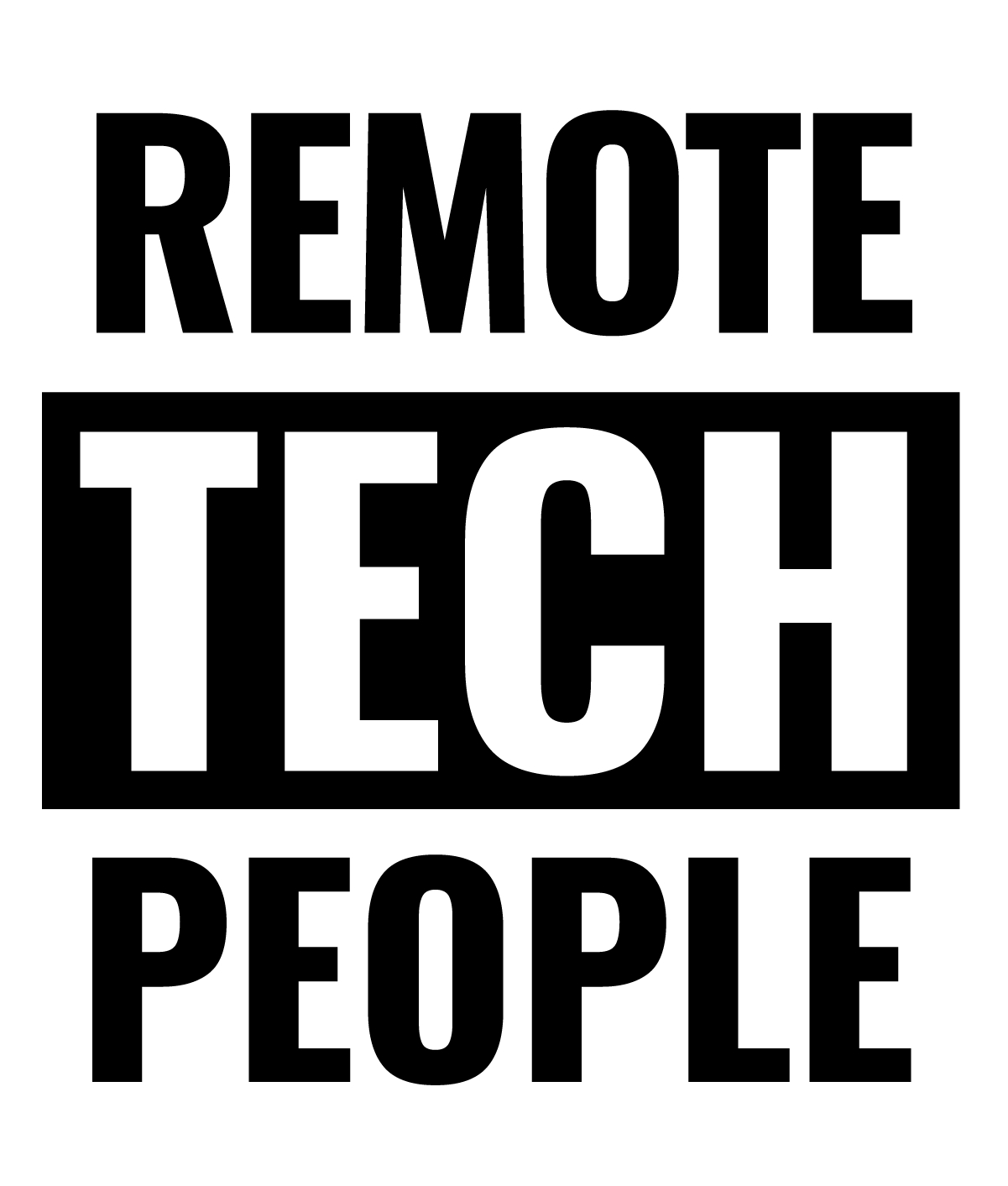
Working with tech professionals to succeed in your Remote-first environment.
RemoteTechPeople
The market has shifted and top technology talent now has options to work across the globe. RemoteTechPeople is an application-only business, working with leading companies across Australia to attract and retain top technology talent. With a dedicated consultant by your side, you’ll be working with someone who truly understands the skills and motivators of the people you want to attract to your business.
Our Process
Our proven roadmap will take you from an empty seat to a productive team member. Being Remote-first specialists we only work with tech professionals who fit your work environment. If you want people to stay long-term the work environment needs to align with individual motivators and our remote-first specialization has proven to increase the chances of success.
Brief
- The most important part of the process, is truly understanding your company and team. Not only skillset but who will succeed in your environment. Opportunity for us to gain clarity around workstyles to attract the right fit
- Not only skillset but who will succeed in your environment.
- Opportunity for us to gain clarity around workstyles to attract the right fit
Branding / Awareness / Selling
- Getting your key message in front of your target audience. Selling your benefits to the motivators of tech professionals. Promoting the benefits of your role/team that Remote-first tech professionals desire
- Selling your benefits to the motivators of tech professionals.
- Promoting the benefits of your role/team that Remote-first tech professionals desire
Selection
- You only work with recruiters specialised in the particular skill set.
- We have deep knowledge of the talent pool.
- Make sure the tech professionals' skills and goals are aligned with your role and company
Hiring / Negotiating
- Helping you through the key decision making.
- We’re experienced in negotiating to help minimise counter-offers and non-acceptance of contracts.
- We have a deep understanding of tech professionals' motivators to avoid last-minute decision changes
Post Placement Success
- We offer a 6-month guarantee period, backing up our claim to find you the right fit.
- Ongoing contact with the successful candidates and your hiring manager to maximise chance of success.
- We gain a greater understanding of your team dynamics to add future members to your team as you grow.
Client Reviews
“Ellen and Linda took the time to not only understand the role we were recruiting for but also the organisation and team culture to ensure the perfect fit. We were thrilled with the high level of service, responsiveness and speed of recruitment.”
– Clair, Employer





Recruit with us
We’re Australia’s only exclusive remote-first technology recruitment agency. We work with companies whose organizational strategy makes working remotely the primary option for their employees. We specialize in working with technology talent looking for Hybrid, and full-remote roles.
Request a free Discovery CallCandidate Reviews
Frequently
Asked
Questions
Yes, we do. We specialise in working with companies that are remote-first. Remote work has taken off at an unprecedented rate in recent years, and many companies are now operating in a hybrid environment. At RemoteTechPeople, we understand the unique challenges that come with managing remote-first teams and have become experts in remote tech recruitment.
Our dedicated team of professionals take the time to deeply understand each company’s specific needs and develop customised solutions for maximum efficiency.
We have experience partnering with organisations from all industries, from publicly-traded corporations to small grassroots businesses, to enable them to transition into a remote-first environment successfully, offering our expertise and guidance in this area is something we are proud to provide our clients.
For employers, remote-first can help to reduce overhead costs associated with physical office spaces and can have a positive impact on the environment by enabling remote employees to reduce their commuting time and carbon footprint.
Additionally, remote-first workspaces promote the growth of remote communities around the world and anyone regardless of location can join a team.
From an employee perspective remote-first often means greater flexibility and autonomy – with remote working comes the ability to adjust your work hours or locations with more creativity.
The consequence is that remote and hybrid teams are usually more diverse, as geographical boundaries no longer play such an important role in determining who is employed in a given job or position.
To put it simply, remote-first is ultimately offering us a potential paradigm shift from where we’ve traditionally worked.
If you’re interested in getting into the “remote-first” technology industry, it’s important to start by identifying a sector that interests you.
Having the right technical skills for your chosen sector will give you an edge over other applicants, so make sure to stay up-to-date with new trends and master your abilities.
In addition to technical expertise, soft skills such as communication and problem-solving are essential for successful remote working, so don’t forget to practice these traits as well.
With hard work and preparation, anyone can break into the “remote-first” technology industry.
Joining remote tech communities and networking with peers is an effective way to get your foot in the door of the industry.
Don’t be afraid to speak up and show what makes you stand out by building relationships with potential employers, sending emails and resumes for job opportunities, and attending interviews.
Putting yourself out there and showing your capabilities will confirm to recruiters that you are dedicated and qualified for a position in one of the top “remote-first” organisations. Now is the time to take action, so seize the opportunity.
Software development is the process of designing, creating, testing, and maintaining software applications and systems.
This involves using programming languages and tools to build software that meets the needs of users. Software engineering is a field that focuses on applying engineering principles to the design, development, and maintenance of software.
Discover the Software Engineer salary range to make an informed choice about your career or an informed decision for your next hire.
This approach uses systematic and scientific approaches to the design, development, testing, and maintenance of software. Software development and engineering are closely related because software engineering approaches are often used in developing software applications and systems.
Read More about Software Development & Engineering
Mechatronics is a branch of engineering that deals with the design and creation of electromechanical systems. These systems may include robots, automated manufacturing equipment, and other complex devices that involve a combination of mechanical and electronic components.
Embedded engineering is a subfield of electrical engineering that focuses on the design and development of embedded systems. Embedded systems are computer systems that are integrated into a larger device or system, often for the purpose of controlling or monitoring that device or system. These systems are typically used in a wide range of applications, including consumer electronics, industrial controls, and transportation systems.
Read More about Mechatronics & Embedded Engineering
Quality Assurance (QA) is a process to ensure that products or services match the standards.
It involves making sure a product or service works well and meets the needs of the customer
Testing is a key part of the QA process. It involves evaluating a product or service by subjecting it to a variety of different tests, either manually or using automated tools, to ensure that it is working correctly and is fit for its intended purpose.
Testing can include:
✅ Functional testing – checking that the product or service performs as intended
✅ Performance testing – checking that the product or service performs well under different workloads and conditions
✅ Security testing – checking that the product or service is secure
… and many other types of testing that help the objectives of the company.
QA and testing are important because they help ensure that products and services are of high quality and meet the user’s needs.
This can lead to increased customer satisfaction, reduced costs due to fewer defects, and improved brand reputation. Every business wants these results.
Read More about Quality Assurance & Testing
Digital marketing refers to the use of the internet and online platforms to promote and sell products or services.
This can include a variety of tactics and techniques, such as search engine optimisation (SEO), social media advertising, email marketing, Google Advertising (PPC), and more.
Design, on the other hand, refers to the process of creating visual content that is appealing, functional, and effective. This can include graphic design, user experience (UX) design, and user interface (UI) design.
Digital marketing and design often go hand in hand, as good design can help to improve the effectiveness of marketing campaigns and make them more appealing to the target audience.
Read More about Digital Marketing & Design
When we see or hear ‘architecture’ most people assume that it is those professionals that can draw a building. Well, there’s a rising profession that is almost hidden from the layperson.
In the tech industry, architecture refers to the design and structure of a system or component. This includes the hardware and software components and the interactions between them.
Architecture is crucial because it determines how a system or component functions and performs. Have you had some apps or tech that are not easy to use? Those apps and tech’s architecture are not up to scratch.
It is critical in the development and maintenance of any tech product, as it provides a framework for the implementation of new features and functionality.
Read More about Architecture in Tech
Data analytics is the process of looking at data to figure out things and make decisions. It uses math and high-level analysis to find patterns in data sets.
Data science is a field that combines computer science, statistics, and domain expertise to extract insights from data. It uses a lot of different techniques, including machine learning, to analyse and interpret data.
Machine learning is a subset of artificial intelligence that involves training algorithms to recognise patterns in data and make predictions or decisions based on that data. It uses large data sets and algorithms to automate the process of finding patterns and making predictions or decisions.
Read More about Data Analytics, Data Science, and Machine Learning.
Infrastructure and cloud operations involve managing, maintaining, and supporting the physical and virtual systems that make up an organisation’s computing systems and services. This includes servers, storage systems, networking equipment, and other hardware as well as the software and platforms that run on these devices.
Cloud operations specifically refer to managing and maintaining cloud computing environments, which involve deploying and operating applications and services in a cloud computing platform such as Amazon Web Services (AWS) or Microsoft Azure.
Infrastructure and cloud operations tasks include monitoring system performance, ensuring data security and integrity, troubleshooting issues, and implementing updates and upgrades.
Read More about Infrastructure & Cloud Operations
Cyber security is the practice of protecting computers, servers, mobile devices, electronic systems, networks, and data from digital attacks, theft, and damage.
Cyber security professionals work to prevent, detect, and respond to cyber threats and vulnerabilities to ensure the confidentiality, integrity, and availability of information and systems.
Some specific tasks that cyber security professionals may perform include:
✅ Conducting security assessments and audits to identify vulnerabilities in systems and networks
✅ Implementing and maintaining security measures, such as firewalls, antivirus software, and intrusion prevention systems
✅ Monitoring and analyzing network traffic for signs of cyber threats
✅ Responding to security breaches and incidents, including conducting investigations and implementing remediation measures
✅ Developing and enforcing security policies and procedures
✅ Providing training and education to employees and users on cybersecurity best practices
✅ Collaborating with other IT professionals and stakeholders to identify and address cyber security risks.
Read More about Cyber Security
Project management is the process of planning, organising, and executing projects in order to achieve specific goals and objectives. This includes identifying and defining the scope of the project, establishing timelines and budgets, and managing resources to ensure the project is completed on time and within budget.
Change management is the process of identifying, analysing, and implementing changes within an organisation. This includes identifying the need for change, developing and implementing a plan to bring about the change, and managing the process to ensure the change is successful and sustainable.
Change management is often used in conjunction with project management to ensure that projects are completed efficiently and effectively.
Read More about Projects & Change
In the remote tech space, senior leadership in leadership teams are individuals who have a strong understanding of technology and its role in driving business success.
They are able to adapt to rapidly changing technology trends and are able to make informed decisions about the direction of their organisation.
Senior leaders in the remote tech space are also adept at managing remote teams and using communication tools and technologies to keep their teams connected and productive. They are able to provide clear direction and guidance to their team and are able to delegate tasks effectively.
In addition, senior leaders in the remote tech space are often strong advocates for diversity and inclusion and work to create a welcoming and supportive work environment for all team members, regardless of location or background. They are also proactive in seeking out new opportunities for growth and innovation and are willing to take calculated risks to drive the success of their organisation.
Read More about Senior Leadership In Tech














